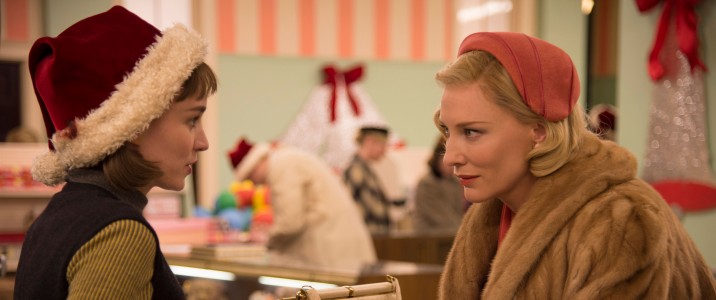At a Q&A conducted after the screening of his latest film, Carol, Todd Haynes admitted that his intent in adapting Patricia Highsmith’s 1952 novel The Price of Salt was to explore a “meditation on first love… set against a culture and series of social morays.” Indeed, Haynes is no stranger to social critique through a post-modernist regard for dialectics within the cinematic apparatus as evident in output like Safe and Far from Heaven, the latter of which bears the most resemblance superficially to Carol. However, what sets this film apart from his earlier explorations of social repression is an emotional immediacy that compels the audience to bask in the sensuous layers of romantic overtures as much as it urges them to consider the ways historicity in fiction informs contemporary issues and vice versa.
The film, which establishes a narrative framework that flashes back from a climactic encounter between two women as witnessed by a tertiary character, explores the dynamic between these women. Therese (Rooney Mara), a diffident employee at a retail store, has vague aspirations as a photographer but no foundation to build any of those dreams upon. Her listless tenure at her thankless job is suddenly jolted into resuscitation when she meets Carol Aird (Cate Blanchett), the titular housewife looking to purchase a train set as a Christmas gift for her daughter. The moment these two meet is charged with potency not only in terms of the immediate attraction that develops between the two, but also because of the very dichotomy drawn between them by class and age. Indeed, the film is coursing with visual and textual instances of doubling, which Haynes establishes not only for an emotional conflict but a sociopolitical one as well. The shared space between Therese and Carol almost seems like an anomaly as expressed by the latter’s harried and soon-to-be divorced husband Harge (Kyle Chandler) when the former comes to their house for a truly awkward visit. Seething with frustration and resentment at his impotence in his doomed marriage, Harge briefly regards Therese and exasperatedly asks, “How do you know my wife again?” Her very presence disrupts the model of an affluent nuclear family that Harge and Carol present towards their peers and friends with great precision but little personal conviction, and Therese’s stance as witness to the dysfunction of a patriarchal partnership posits her as a greater threat than any of the acquaintances the Airds invite to their holiday cocktail party.
Certainly, the visual duality Haynes and his director of photography Edward Lachman reinforce in their evocation of the 1950s is a vision that is both luxuriant and understated. The hues of green, red, and pink, though vibrant, are also imbued with a sort of flat quality that alludes to the post-war ennui that undermines the glamour associated with Carol’s social stature. By opting to shoot on Super 16 mm film, Haynes confessed that he strove to emulate the work of photographer Saul Leiter rather than American cinema of the period as he did for his Sirkian tribute Far From Heaven. By framing the characters within windows speckled with raindrops, the film obfuscates our collective view of said figures and, in Haynes’ words, stokes “the desire to look” within the audience. This space occupied by the viewer is challenged particularly in the second half of the film when, on a whim, Carol decides to spend the end of the year on a road trip with Therese. Without divulging in precisely what transpires, suffice to say that the eroticism simmering under the surface for the majority of the plot comes to the fore in an instant of poignant tenderness that, rather than indulging in our voyeuristic desires, aligns us with Carol and Therese before promptly suturing us and raising our awareness of the agency both women attain that is separate from our own.
Ultimately, what distinguishes Carol as a powerful work of political filmmaking is not only its concerns with the consequences of late capitalism ensconced in the candy-colored Christmas season, nor simply the transgressive defiance of the American social strata both then and now, but a truly raw affirmation of love. The performances are instrumental in preventing this parable from slipping into cinematic didacticism, and Haynes’ cast is more than up to the task. Blanchett, the radiant beauty who seems utterly incapable of giving a forgettable performance, masterfully conveys sexual swagger and confidence (even a mere wink she briefly gives Therese is charged with natural charisma and allure) that is in itself a pretense for the emotional abyss Carol finds herself constantly straying on the edge of. It is a performance of a performance by a performer who rarely gives the impression that she is performing. But Mara’s role is just as challenging for the opposite reason; where Carol exudes a grandiose presence the moment we spot her in her fur coat and pink hat, the gradual transformation Therese makes from a girl whose shadow of an identity is subtly filled by her discovery of her own capabilities is more subtle if no less significant. The remainder of the ensemble is excellent, particularly Chandler who injects a pitiable humanity in what would otherwise be an ostensibly monstrous antagonist, but the film firmly belongs to its two leads from its opening sequence to the final shot.
Indeed, without spoiling the denouement, consider the manner in which Haynes ends the story, nearly identical to that of Highsmith’s novel. Her conclusion was downright subversive for the period, and now Haynes urges us to consider similar implications in the 21st Century, particularly in the wake of nationwide legalization for gay marriage. While a knee-jerk reaction to the ending may suggest that Haynes loses his verve, I think nothing could be further from the truth. After all, what could be more radical than a previously unthinkable union that surpasses a so many implacable societal boundaries?
